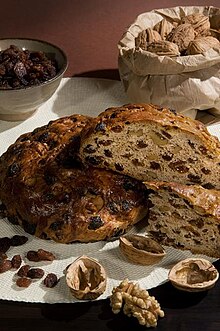Pane coi santi
 | |
| Alternative names |
|
|---|---|
| Type | fruit bread |
| Place of origin | Italy |
| Region or state | |
| Main ingredients | bread dough, olive oil, raisins, walnuts |
| Variations | figs, dates, almonds, honey, pine kernels |
Pane coi santi is a traditional Italian fruit bread.[1]: 51 It is baked in a wood-fired oven and is eaten at about the time of I Santi on 1 November and I Morti on the following day. It is a speciality of Siena and the Maremma, and is among the products of Tuscany with prodotto agroalimentare tradizionale status.[2]
History
[edit]Pane coi santi is a traditional Italian regional product, strongly associated both with the city of Siena and with the feast of I Santi on 1 November and I Morti on the following day.[3]: 89 [4]: 66 George Gissing wrote in his diary for 1 November 1897: "At Siena (and here only) they eat to-day a kind of very plain plum-cake called Pane coi santi".[5]: 452
Preparation
[edit]The traditional ingredients are flour, olive oil, raisins and walnuts.[4]: 66 Other ingredients may include almonds, pine kernels, honey, figs and dates.[6]: 172 [7]: 152
The flour is used to make a leavened bread dough, into which the other ingredients are then mixed.[6]: 172 It is then formed into a low round or oval loaf and baked in a wood-fired oven. The result is fragrant, of a moderately dark brown, and fairly soft.[3]: 89
References
[edit]- ^ Michele Scicolone (1993). La Dolce Vita. New York: W. Morrow. ISBN 9780688111496
- ^ Allegato al decreto PAT 2019 (in Italian). Ministero delle politiche agricole alimentari, forestali e del turismo. Accessed November 2021.
- ^ a b Luigi Cremona (2004). L'Italia dei dolci (in Italian). Milan: Touring Club Italiano. ISBN 9788836529315.
- ^ a b Giuseppe Rigutini, Pietro Fanfani (1864). Giunte ed osservazioni al Vocabolario dell'uso toscano (in Italian). Firenze: Cellini e C.
- ^ George Gissing, Pierre Coustillas (editor) (1978. London and the Life of Literature in Late Victorian England: The Diary of George Gissing, Novelist. Hassocks: Harvester Press. ISBN 9780855277499.
- ^ a b Grazietta Butazzi, Tino Buazzelli (1988). Toscana in bocca. Palermo: La Nuova Edrisi. ISBN 9788878090118.
- ^ Gino Cervi, Monica Maraschi (2005). Authentic Tuscany. Milan: Touring Club Italiano. ISBN 9788836532971.
Text is available under the CC BY-SA 4.0 license; additional terms may apply.
Images, videos and audio are available under their respective licenses.
